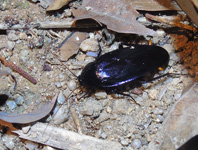Abstract
Previous studies on the mollusks from Brazilian underwater canyons have addressed the record and description of new species of aplacophorans, bivalves, scaphopods and/or gastropods (Leal & Simone 2000; Absalão 2010; Corrêa et al. 2014). Leal & Simone (2000) described a new bathyal gastropod of the family Pseudococculinidae collected from the continental slope and Doce River Canyon (960 m) off the state of Espírito Santo (southeastern Brazil). Absalão (2010) reported a number of species of gastropods, bivalves and scaphopods from Campos Basin off the state of Rio de Janeiro (southeastern Brazil). It is likely that some of these species reported by Absalão (2010) were collected from underwater canyons in the northern portion of the Campos Basin. Corrêa et al. (2014) recorded two species of aplacophorans of the genus Falcidens Salvini-Plawen, 1968 obtained from the continental slope and underwater canyons of Campos Basin. Certainly more species of mollusks were studied from Brazilian underwater canyons, but not duly mentioned in publications (i.e., the region of canyons may have been referred to as the continental slope or deep sea).
References
Absalão, R.S. (2010) Mollusca. In: Lavrado, H.P. & Brasil, A.C.S. (Eds.), Biodiversidade da Região Oceânica Profunda da Bacia de Campos: Macrofauna. SAGServ, Rio de Janeiro, pp. 29–95.
Bouchet, P. & Warén, A. (1993) Revision of the Northeast Atlantic Bathyal and Abyssal Mesogastropoda. Bollettino Malacologico, 3 (Supplement), 579–840.
Ceregato, A. & Tabanelli, C. (2005) Il genere Ceratia Adams H.A., 1852 nei depositi Pliocenici della Romagna (Mollusca Mesogastropoda Rissoidea Iravadiidae). Quaderno di Studi e Notizie di Storia Naturale della Romagna, 20, 7–13.
Corrêa, P.V.F., Fassina, P.V. & Passos, F.D. (2014) Falcidens targatus and F. acutargatus: two species of Caudofoveata (Mollusca, Aplacophora) new for Brazil. Journal of Natural History, 48 (45–48), 2947–2963.
http://dx.doi.org/10.1080/00222933.2014.959575Fukuda, H. (2000) Ceratia nagashima, sp. nov. (Gastropoda: Sorbeoconcha: Iravadiidae) from Tanoura, Nagashima Island, Kaminoseki-chô, Yamaguchi Prefecture, Japan. The Yuriyagai: Journal of the Malacozoological Association of Yamaguchi, 7 (2), 101–113.
Fukuda, H., Haga, T. & Tatara, Y. (2008) Niku-nuki: a useful method for anatomical and DNA studies on shell-bearing molluscs. Zoosymposia, 1, 15–38.
http://dx.doi.org/10.11646/zoosymposia.1.1.5Golding, R.E. (2014) Molecular phylogeny and systematics of Australian ‘Iravadiidae’ (Caenogastropoda: Truncatelloidea). Molluscan Research, 34 (4), 222–257.
http://dx.doi.org/10.1080/13235818.2014.888971le Renard, J. (1993) Clefs de determination des petites especes de gasteropodes de l'Eocene du bassin Parisien. 40 - La famille des Iravadiidae Thiele, 1928. Cahiers des Naturalistes, 49 (4), 77–105.
Leal, J.H. & Simone, L.R.L. (2000) Copulabyssia riosi, a new deep-sea limpet (Gastropoda: Pseudococculinidae) from the continental slope off Brazil with comments on the systematics of the genus. The Nautilus, 114 (2), 59–68.
Lima, S.F.B., Santos, F.N. & Absalão, R.S. (2013) New Species of Caecum (Caenogastropoda: Rissooidea: Caecidae) from the Atlantic Coast of South America (Brazil) with a Description of the Protoconch and Growth Stages. Zoological Science, 30 (9), 767–778.
http://dx.doi.org/10.2108/zsj.30.767Lozouet, P. (2003) A new species of Iravadia s.s. (Mollusca, Gastropoda, Iravadiidae) from the late Oligocene of the Aquitaine Basin (southern France). The earliest record of brackish-water Iravadiidae? Geodiversitas, 25 (2), 237–242.
Ponder, W.F. (1984) A review of the genera of the Iravadiidae (Gastropoda: Rissoacea) with an assessment of the relationships of the Family. Malacologia, 25 (1), 21–71.
Ponder, W.F. & Keyzer, R.G. (1998) Part B. Superfamily Rissooidea. In: Beesley, P.L., Ross, G.J.B. & Wells, A. (Eds.), Mollusca: The Southern Synthesis. Fauna of Australia. Vol. 5. Part B. CSIRO Publishing, Melbourne, pp. viii + 745–766.
Rios, E.C. (2009) Compendium of Brazilian Sea shells. Evangraf, Rio Grande, RS, 668 pp.
Warén, A. (1980) Marine Mollusca described by John Gwyn Jeffreys, with the location of type material. Conchological Society of Great Britain and Ireland. Special Publication, 74, 1–28.
Warén, A. (1996) New and little known Mollusca from Iceland and Scandinavia. Part 3. Sarsia, 81, 197–245.
Watson, R.B. (1886) Report on the Scaphopoda and Gasteropoda collected by H.M.S. 'Challenger' during the years 1873–1876. Report on the Scientific Results of the Voyage of H.M.S. Challenger, Zoology, 15, 1–756.

